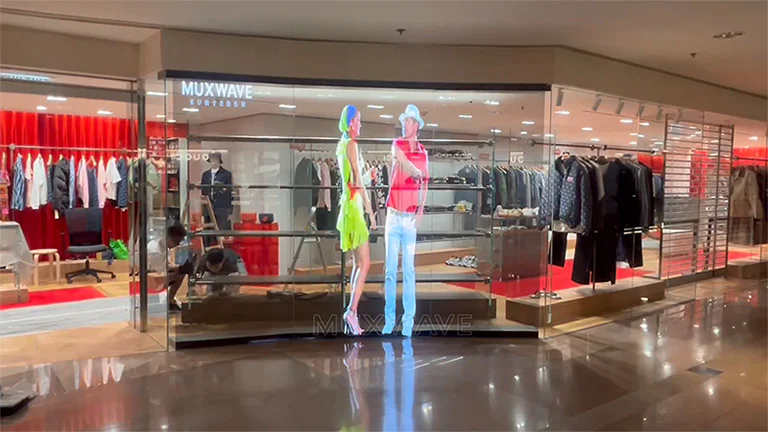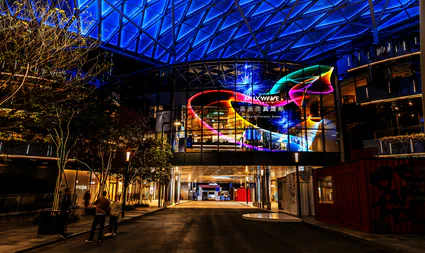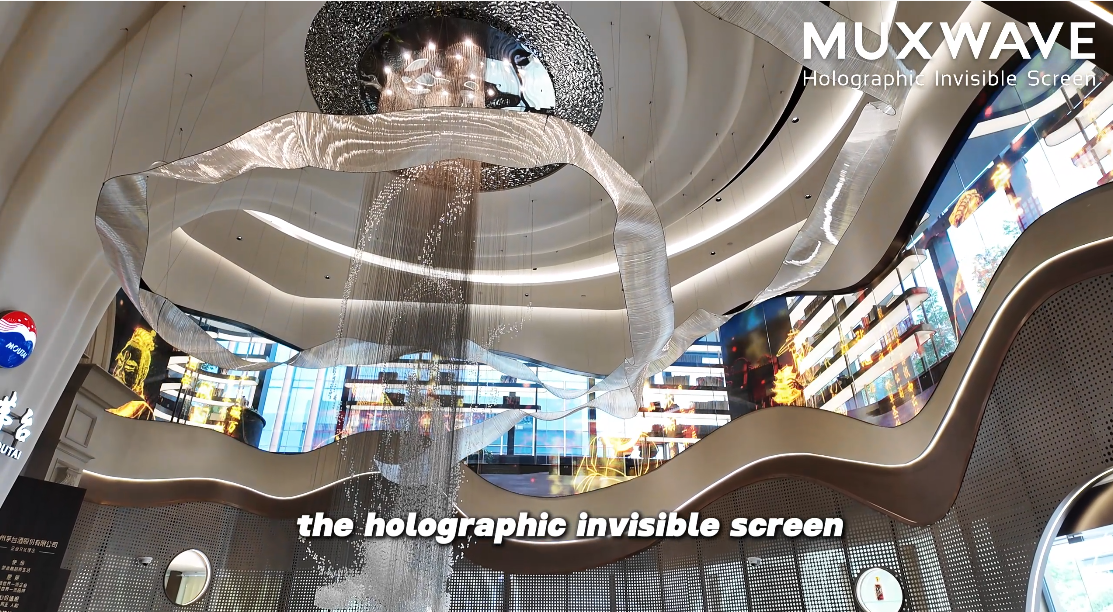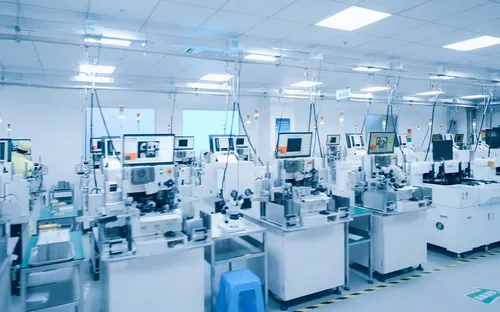Introduction
A New Era of Digital Transparency
Imagine walking past a glass storefront, and instead of a bulky display or a solid lightbox, you see videos and text floating directly on the glass—without blocking the view inside. This is the promise of transparent LED film, a revolutionary evolution in LED display technology that merges digital content with architectural transparency.
Unlike traditional LED panels or projection systems, transparent LED film screens are thin, flexible, and light-transmissive, meaning they can be applied directly onto glass surfaces to create vibrant digital signage while maintaining visibility through the glass. It’s technology that blends seamlessly into spaces, turning any window or glass wall into a communication surface.
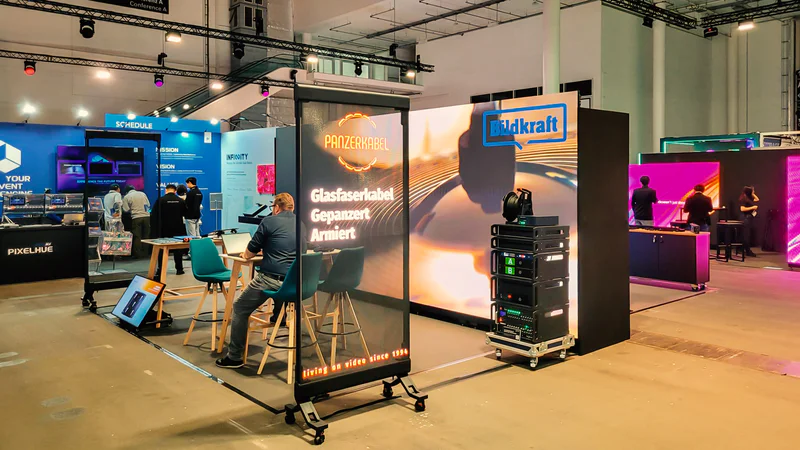
What Exactly Is Transparent LED Film?
Definition
A transparent LED film is a light-emitting diode (LED) display layer built on a flexible, transparent substrate, usually PET (polyethylene terephthalate) or similar polymer material. LEDs are mounted in a grid-like pattern onto this transparent sheet using microcircuit wiring that is nearly invisible to the eye.
When powered, each LED emits light—forming images, animations, or videos—while the gaps between LEDs allow natural light and background visibility to pass through.
Key Components
- Transparent Substrate: A thin PET or glass-laminate base that carries the LED circuits while remaining flexible.
- Micro LEDs or SMDs: Tiny diodes embedded in the film; their size determines pixel pitch and resolution.
- Conductive Circuits: Microscopic copper or silver traces connecting each diode, engineered to be optically clear.
- Adhesive Layer: Allows the film to stick directly to glass or acrylic without visible residue.
- Control & Power System: Compact drivers and data cables often concealed in window frames or ceilings.
Visual Effect
The result is an “invisible” digital layer—when off, the film looks like ordinary glass; when on, it delivers vivid images that appear to float in space.
How Transparent LED Film Works
The Optical Principle
A transparent film LED screen relies on the contrast ratio between emitted light and ambient light. Each LED generates its own light, unlike LCDs that require backlighting. This self-emissive nature means images stay visible even in bright environments, as long as brightness exceeds the surrounding lux level.
Transparency is achieved through spacing between the LED pixels—for example, a 10 mm pixel pitch means only a small portion of the surface contains LEDs, leaving over 80% of the glass area open for light transmission.
Pixel Pitch and Transparency
| Pixel Pitch (mm) | Transparency (%) | Typical Viewing Distance (m) | Use Case |
|---|---|---|---|
| 2–3 mm | 60–70% | 2–5 m | Indoor retail, exhibitions |
| 5–7 mm | 70–80% | 5–10 m | Shop windows, airports |
| 10–20 mm | 80–90% | 10–30 m | Large façades, glass walls |
A smaller pitch yields sharper images but reduces transparency slightly, while wider spacing enhances see-through clarity.
Day and Night Adaptation
In daylight, brightness settings (measured in nits) increase—often reaching 3000–5000 nits—so that digital content can outshine direct sunlight.
At night, automatic dimming systems reduce brightness to 300–800 nits to prevent glare and maintain transparency.
Types of Transparent LED Film Screens
Rigid Transparent LED Panels
Mounted inside glass frames, these are less flexible but offer higher structural stability. Common for fixed architectural façades.
Rollable Transparent LED Film
The true innovation—flexible, adhesive LED film that can be rolled, cut, and fitted to curved or irregular surfaces. Ideal for retail and transport hubs.
Glass-Integrated Transparent LED Displays
Here, LEDs are embedded directly within laminated glass during manufacturing. Provides a flawless aesthetic but is less serviceable and more expensive.
Transparency: The Core Advantage
Aesthetic Integration
Transparent LED films preserve architectural openness. Buildings can maintain their natural light and visibility, avoiding the “closed” look of opaque digital billboards.
Natural Lighting Compatibility
Because the display doesn’t block sunlight, it supports sustainable building design by maintaining daylight penetration—reducing artificial lighting needs.
Lightweight and Easy to Install
Unlike traditional LED cabinets, which can weigh 40–60 kg/m², transparent film LED screens weigh only 2–4 kg/m², making them suitable for existing glass structures.
Energy Efficiency
The ultra-transparent film LED screen emits light only from active pixels, consuming less energy than full-backlit systems.
Engineering Focus: Pixel Pitch and Brightness
What Is Pixel Pitch?
Pixel pitch defines the distance between two adjacent LEDs. A smaller pitch equals higher resolution but lower transparency. Designers balance these factors based on viewing distance and installation height.
- Close-up retail displays (2–5 m): Use P2.5–P3.
- Medium distance (5–10 m): Use P5–P7.
- Long-range façades (10–30 m): Use P10–P15.
Why Brightness Matters
A transparent film LED screen must outperform ambient light, especially in outdoor or atrium conditions. Most modern films deliver 2500–5000 nits, adjustable via control software or sensors.
The Transparency-Brightness Tradeoff
Higher brightness requires denser LEDs, which slightly lowers transparency. High-end films solve this with micro-LEDs and optical diffusion coatings that scatter light efficiently while maintaining clarity.
How It’s Installed
Step 1: Site Evaluation: Check glass structure integrity, surface treatment, and cable routing feasibility.
Step 2: Cutting and Positioning: Films are typically delivered in rolls. They can be cut to exact window dimensions or shaped for curves and corners.
Step 3: Adhesion:The self-adhesive layer is pressed directly onto the inner glass face (protected from weather). Installers remove air bubbles to ensure optical clarity.
Step 4: Power & Data Connection: Thin cables connect the film to control boxes hidden in ceilings or frames. Daisy-chained connections minimize wiring clutter.
Step 5: Calibration: Brightness and color balance are fine-tuned for the specific glass thickness, tint, and local lighting conditions.
Typical Applications
Retail Storefronts
The most common use. Transparent LED films turn shop windows into interactive digital billboards while keeping interiors visible.
Example: A luxury brand displays full-screen animations across glass, but customers inside still enjoy daylight.
Corporate Lobbies & Atriums
Adds visual interest without obstructing architectural transparency.
Example: An office atrium displaying animated brand visuals on a transparent led film screen behind glass elevators.
Museums & Exhibitions
Perfect for storytelling overlays—digital content appears suspended over artifacts.
Example: An artifact case enhanced by a transparent film LED screen explaining its history.
Transportation Hubs
Used in airports, subways, and train stations for wayfinding and dynamic advertising on glass walls.
Architecture & Media Façades
Entire glass buildings can act as dynamic canvases after dark, transforming into ultra transparent film LED screens that display media art or branding.
Design and Content Principles
To make the illusion effective and readable, creative teams follow these guidelines:
- Use macro shapes and bold motion. Fine text or thin lines disappear on transparent backgrounds.
- Keep high local contrast. Bright subject against mid-dark background.
- Avoid pure white backgrounds. They reduce see-through effect and strain brightness control.
- Use drop shadows or glows. These create depth against the transparent layer.
- Plan for night palettes. Darker, softer colors maintain comfort and prevent reflections.
Performance Metrics and Specifications
| Parameter | Typical Range | Description |
|---|---|---|
| Transparency | 70–90% | Depends on pitch & LED density |
| Brightness | 2500–5000 nits | Adjustable for day/night |
| Pixel Pitch | 2 mm–15 mm | Defines resolution and viewing distance |
| Film Thickness | 1–3 mm | Flexible and lightweight |
| Power Consumption | 200–400 W/m² | Based on brightness and content APL |
| Operating Temperature | -10°C to +45°C | Indoor and semi-outdoor use |
| Weight | 2–4 kg/m² | Ideal for existing glass |
| Lifetime | 80,000–100,000 hrs | Typical LED lifespan |
Maintenance and Durability
Transparent LED films are low-maintenance by design:
- Encapsulated LEDs prevent dust and moisture ingress.
- Static-free surface reduces dirt accumulation.
- Front-service design means entire sheets can be replaced without dismantling frames.
- Firmware updates allow remote brightness and power optimization.
Economic & Environmental Advantages
Lower Structural Costs
No need for heavy mounting frames or reinforcement—reduces installation cost by up to 60% compared with cabinet LEDs.
Energy Savings
Smart dimming and content management can reduce power consumption by 30–40% versus traditional LED walls.
Sustainable Building Integration
Transparent LED films preserve natural light, supporting LEED and green-building certifications.
Challenges and Limitations
Despite the benefits, transparent LED films have constraints:
- Brightness vs Transparency: Striking balance remains a design challenge.
- Resolution Limits: High-res films are costlier and harder to maintain.
- Outdoor Exposure: Most films are for indoor or semi-outdoor use; full outdoor versions require protection.
- Content Legibility: Without opaque background, readability depends on ambient contrast.
Future Developments
MicroLED Integration
Emerging microLED transparent films deliver higher pixel density and better contrast at lower power.
Curved & 3D Surfaces
Future models will support full wrap-around glass applications for cars, architecture, and wearables.
Smart Sensors
Next-gen transparent film LED screens will integrate light, proximity, and temperature sensors, enabling adaptive brightness, interactive content, and real-time analytics.
IoT and AI Control
AI-driven systems can predict ambient light and automatically adjust brightness and content tones to maintain visual comfort and reduce energy.
Transparent LED Film vs Other Technologies
| Feature | Transparent LED Film | LED Transparent Panels | OLED Transparent Displays |
|---|---|---|---|
| Transparency | 70–90% | 60–85% | 40–50% |
| Flexibility | High | Low | Moderate |
| Brightness | 3000–5000 nits | 4000–6000 nits | 500–1000 nits |
| Durability | Excellent | Excellent | Sensitive to humidity |
| Weight | 2–4 kg/m² | 40–60 kg/m² | ~20 kg/m² |
| Cost | Medium | High | Very high |
| Installation | Simple, adhesive | Framed | Built-in glass |
| Outdoor Use | Semi-outdoor | Outdoor | Indoor only |
Verdict:
For architectural and retail installations prioritizing transparency, lightweight build, and flexibility, LED transparent film display screens outperform most alternatives.
Step-by-Step Buyer’s Guide
- Step 1 Define Objectives: Is your goal branding, advertising, artistic display, or architectural media façade?
- Step 2 Choose Viewing Distance: Decide ideal pixel pitch based on audience proximity and window size.
- Step 3 Evaluate Lighting Conditions: Bright sunlight? Choose ≥4000 nits film. Indoor atrium? 2500 nits is plenty.
- Step 4 Pick Transparency Level: For retail or museums, 70–80% transparency is optimal; for façades, >85% ensures clear visibility inside.
- Step 5 Confirm Power & Data Routing: Consult engineers early—clean cabling equals cleaner visuals.
- Step 6 Partner with a Reliable Supplier: Look for transparent LED film manufacturers offering custom cutting, service warranties, and content calibration support.
Maintenance & Lifecycle Optimization
- Scheduled Cleaning: Gentle microfiber and mild detergent prevent streaks.
- Regular Diagnostics: Software monitors dead pixels and power draw.
- Firmware Updates: Keep driver ICs optimized for brightness and refresh control.
- Component Recycling: PET substrates and LEDs can be recycled; inquire about end-of-life plans.
Where It Fits: Ideal Environments
| Environment | Why It Works |
|---|---|
| Retail Windows | Advertising + transparency; draws foot traffic. |
| Corporate Glass Walls | Enhances brand image without obstructing view. |
| Museums & Galleries | Digital storytelling overlays on exhibits. |
| Airports & Transit Hubs | Wayfinding & data updates on glass partitions. |
| Hotels & Restaurants | Artistic ambiance and interactive displays. |
| Architectural Façades | Media art without compromising daylight. |
Key Takeaways
- Transparent LED film merges display and architecture into one.
- It offers lightweight, flexible, and energy-efficient digital surfaces.
- Its transparency depends on pixel spacing and brightness control.
- Ideal for storefronts, atriums, museums, and glass façades.
- Easy installation and low maintenance make it scalable across multiple sites.
- As technology evolves, expect higher resolutions, smarter brightness control, and increased interactivity.
Conclusion: The Future Is Clear
The future of display technology lies in integration, not intrusion.
As brands and architects seek seamless digital experiences, transparent LED film screens are setting a new standard—merging content with structure, form with function, and glass with light.
From ultra-transparent film LED screens in retail to LED transparent film display screens in cultural spaces, this technology reshapes how we use surfaces for communication—without walls, without bulk, and without blocking the view of the world outside.
It’s not just transparent—it’s transformative.
Would you like me to generate a featured image for this article (e.g., showing glass windows with embedded transparent LED film glowing under daylight)?
